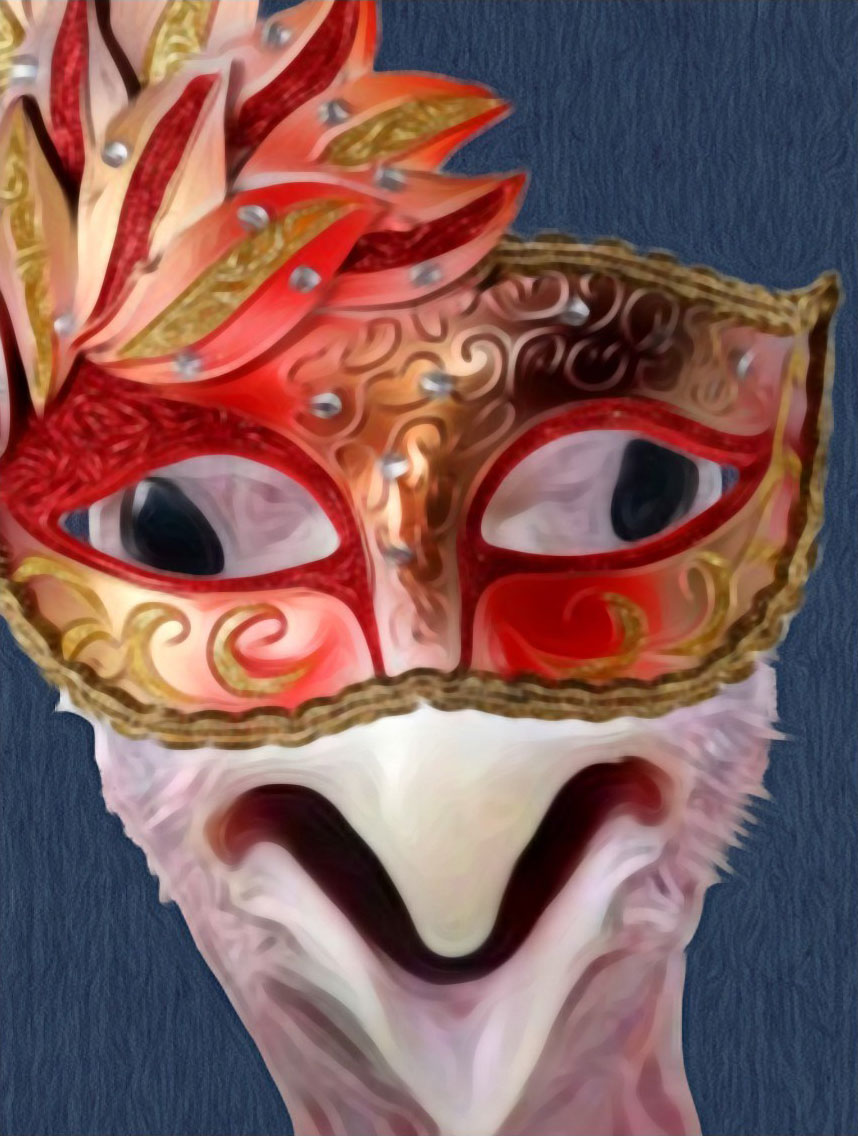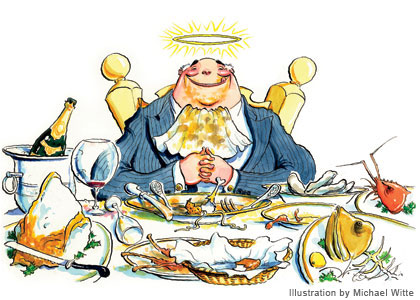The Thanksgiving Turkey as Ritual Scapegoat in The Carnivalesque Tradition
By Karen Davis, PhD, President of United Poultry Concerns
Published as an
original article on Animals 24-7
November 17, 2018.
Empathy versus Animus Toward Animals and Animality

(Beth Clifton collage)
Human radical abuse of “food” animals cannot be explained on grounds of economic efficiency alone. It is also an outgrowth of attitudes humans have had toward nonhuman animals through the ages, rooted in our resentment at being animals, which we project onto them. In his book An Unnatural Order, Jim Mason calls this mentality “misothery,” a term in which he combines the Greek words for “hatred” or “contempt,” and “animal.”
But while many people harbor cultural or personal misothery toward nonhuman animals and the “degrading” condition of animality, we are ambivalent about our own attitudes. We are animals, after all, whose knowledge of our animal kinship is encoded in our genes.
A basis for some hope, in this time of surpassing cruelty to billions of farmed animals and others on the planet, is the empathy many people feel toward animals, which may be gaining ground on the animus that has defiled so much of our relationship with other species and the natural world.
Meanwhile, our treatment of turkeys remains a conspicuous example of “misothery.” Because of the turkey’s mythic role in American history, the turkey comes loaded with all the ambiguity this role implies. Just as the wild bird and the domestic bird are joined ambiguously in the public image and the DNA of the “Thanksgiving Turkey,” so the turkey appears, if marginally thus far, in the role of an ambassador for a kinder, more generous experience of Thanksgiving.
By adopting turkeys and having them as guests at the Thanksgiving table, farmed animal sanctuaries show through a different set of symbols that there are other ways of saying thank you than by cynically thanking the turkey for “giving itself” to us. But this is a long way from the mainstream perspective, in which the charm of a turkey consists in “taste” while providing the easiest way to feel part of a community by eating and saying what everyone else does.
Conventionally, the turkey has been cast as a creature addicted to filth and infected with harmful bacteria. The turkey magically becomes clean only by being killed, soaked in slaughterhouse acid, cooked, and consumed.
Often characterized as “dirty” and “stupid,” though turkeys are neither, the turkey figures in the seemingly incompatible role of a sacrifice (a pure, precious offering), while serving as a scapegoat under the collective idea that heaping society’s impurities onto a symbolic creature and “banishing” or slaughtering that creature can somehow bring purification.
The “purification” ritual at Thanksgiving is equated with patriotism.
Scapegoats are Innocent Victims
Scapegoats are not just victims; they are innocent victims who are blamed and punished for things they are not responsible for. In the Mosaic ritual of the Day of Atonement, as described in Leviticus 16, the scapegoat was one of two goats chosen by lot to be sent into the wilderness, the sins of the people having been symbolically laid upon it; the other goat was chosen for sacrifice.
In Christianity, Jesus is not only the shepherd. He is the innocent lamb who bears away the sins of the world and sheds his blood for human salvation.
In ancient Greek religion, a pharmakos was the ritual sacrifice or exile of a human scapegoat or victim. A slave, a cripple or a criminal was chosen and ousted from the community in times of disaster such as famine, invasion or plague, in the belief that this action would restore purification to the people.
Scapegoats are not always seen as such by scapegoaters, because scapegoating is not about evidence but about transferring blame. People often do not fully recognize – or understand – what they are doing when they participate in scapegoating. The scorn heaped on the turkey at Thanksgiving suggests an awareness of scapegoating on the part of those who practice it. But such awareness, if it exists, does not necessarily inspire caring or change. On the contrary, it may be self-enforcing.
The idea of the Thanksgiving turkey as a scapegoat may seem like a parody of scapegoating. Yet what is the scapegoat phenomenon but a parody of reason and justice? The scapegoat, after all, is a goat.
Animals have been scapegoated in storytelling, myth, and history since time immemorial. In “Generative Scapegoating,” in Violent Origins: Ritual Killing and Cultural Formation, French social scientist Rene Girard explains how, throughout the world, “all animals with gregarious habits, even if completely harmless to each other and to man,” have been vilified.
Under European penal codes from the 12th to the middle of the 18th century, for instance, “guilty” animals were subjected to everything from being buried alive to being hanged, often after mangling and other tortures were inflicted. Animals were put to the rack to extort confessions, and in classic scapegoat fashion, they were banished from the place of their alleged crime.
“Buggery” – sexual intercourse – in which turkeys and other farmed animals were assaulted by men and boys in Pilgrim society – “was uniformly punished by putting to death both parties implicated, and usually by burning them alive,” writes E.P. Evans in The Criminal Prosecution and Capital Punishment of Animals. Occasionally, he says, “an appeal led to the acquittal of the accused.”
Considering this history, it isn’t farfetched to see the annual White House turkey “pardoning” ceremony by the president of the United States on the eve of Thanksgiving as an inverted scapegoat ritual, a parody of a parody burlesquing “the acquittal of the accused.”
Blame the Turkey

UPC Sanctuary Turkey, Boris.
Photo by Susan Rayfield
So how does the turkey fit the scapegoat pattern? Consider that not everyone is as happy at Thanksgiving or Christmas as we’re supposed to be. Two cultures coincide during the holidays: the official, “pious” culture epitomized by Plymouth Rock and the like, versus a miscellany of dissident, unhappy, irreverent, marginalized individuals and groups. If a citizen wishes to express discontent with the holiday, “blaming” the turkey allows a certain amount of criticism and resentment to seep derisively into a celebration that taboos serious criticism or reflection.
The turkey thus functions as a bearer of impious sentiments deflected from their true causes, like the obligation to be thankful whether one is thankful or not. Sorrow and injustice are not the fault of the bird whose fate, after all, is to be murdered for the meal, which makes many people deeply unhappy while ordinary citizens rejoice.
As a scapegoat bearing a burden of derision, the turkey is in the carnivalesque tradition of taunting and torment, wherein “all that was terrifying becomes grotesque,” writes Mikhail Bakhtin in his classic study Rabelais and His World. Opposite the sanctimony of pious occasions, the carnivalesque spirit emphasizes sarcasm, indecent abuse, a comically repulsive concept of the body, and the gargantuan banquet ending a period of ritual abstinence such as Lent, or the Harvest Festival celebrating the harvest, of which the American Thanksgiving is an offshoot. The basic content of the carnivalesque spirit is “free play with the sacred” which seeks to defeat fear in a “droll and monstrous form.”
Bakhtin stresses that the carnivalesque spirit of mockery and abuse “is almost entirely bodily and grotesque.” Only the eyes, he says, “have no part in these comic images,” because eyes “express an individual, so to speak.”
Prurient Underside of Thanksgiving
Nobody laughs at the eagle. For impiety you have the turkey. The turkey functions as the butt of marketplace humor opposite the sanctimony of Thanksgiving. In media coverage, the turkey has been called a “humongous mutant” and many other derisive epithets designed to tickle people’s fancy and distance them morally from the bird. The turkey, in carnivalesque fashion, is likened to bloated sex symbols and caricatured in cartoons of little boys crawling into the turkey’s vent at the Thanksgiving dinner table – “Send in small boy with a knife and instructions to find his way out again.”
Thus is revealed the prurient underside of Thanksgiving.
The modern “industrialized” turkey’s swollen body, distorted physical shape, and inability to mate naturally are the result of the farming industry’s violent genetic assault on the body of a bird who evolved in nature to be strong, fit, and vigorous, reminding us not only of the cruel arbitrariness of fate, but of the sinister power of humanity.
The carnivalization of the turkey functions as a magic formula for conquering the human fear of being a “turkey.” We poke so as not to be poked at. By devouring another, we master our fear of being devoured. Fear of our own potential for gluttony, of being helplessly manipulated by the cosmic scheme, our fellow man, and our own folly is transposed to the comic monster we are about to consume.
Purification Consists in Devouring and Being Devoured
The bird, so conceived, becomes purified and redeemed only by being absorbed back into the bowels of Man. Theriomorphy, a term meaning a circumstance in which a human and a nonhuman animal come together in one body, takes place under these circumstances in a consummation in which an innocent creature otherwise maledicted as dirty and stupid undergoes transmutation. The “profane” animal becomes the sacred feast.
Such is the carnivalesque universe epitomized in Bakhtin’s summation of the psychology of this universe: “The victorious body receives the defeated world and is renewed by the very taste of the defeated world. Man triumphs over the world, devours it without being devoured himself.”
The Thanksgiving turkey ritual has all the trappings, including the “happy ending,” of the traditional scapegoat ritual, in which a “culprit” is transformed into a “benefit” to society.
Donald Trump’s Favorite Feast
The psychology of the carnivalesque enterprise is currently on display at the U.S. presidential level, where the “pious solemnity” of the presidency has been invaded and upended by the carnivalesque impudence of Donald Trump, whose favorite “food,” one might say, is “the taste of the defeated world.”
Tragically for the earth and its creatures, Donald Trump is not an anomaly, and the ritual of traditional Thanksgiving is in essence a daily exercise in need of radical transformation.

References
Bakhtin, Mikhail. 1967. Rabelais and His World. Trans. Helene Iswolsky. Cambridge: MIT Press.
Davis, Karen. 2001. More Than a Meal: The Turkey in History, Myth, Ritual, and Reality . New York: Lantern Books.
Evans, E.P. 1998. The Criminal Prosecution and Capital Punishment of Animals. Union, NJ: The Lawbook Exchange, Ltd. First published 1906.
Girard, Rene. 1987. “Generative Scapegoating.” In Violent Origins: Ritual Killing and Cultural Formation, ed. Robert G. Hammerton-Kelly, 73-145. Stanford: Stanford University Press.
Mason, Jim. 1993. An Unnatural Order: Uncovering the Roots of Our Domination of Nature and Each Other. New York: Simon & Schuster. Now available from Lantern Books.
KAREN DAVIS, PhD is the President and Founder of United Poultry Concerns, a nonprofit organization that promotes the compassionate and respectful treatment of domestic fowl including a sanctuary for chickens in Virginia. Inducted into the National Animal Rights Hall of Fame for Outstanding Contributions to Animal Liberation, she is the author of Prisoned Chickens, Poisoned Eggs: An Inside Look at the Modern Poultry Industry, More Than a Meal: The Turkey in History, Myth, Ritual, and Reality, The Holocaust and the Henmaid’s Tale: A Case for Comparing Atrocities and other groundbreaking works.
Learn More About Turkeys
- Turkeys on www.upc-online.org
- UPC Turkeys Brochure
- Turkeys – Who Are They?
- More Than A Meal: The Turkey in History, Myth, Ritual, and Reality
- Peeper: A Story of Unending Love